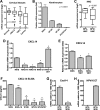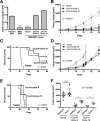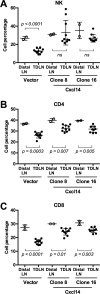Suppression of Antitumor Immune Responses by Human Papillomavirus through Epigenetic Downregulation of CXCL14
- PMID: 27143385
- PMCID: PMC4959654
- DOI: 10.1128/mBio.00270-16
Suppression of Antitumor Immune Responses by Human Papillomavirus through Epigenetic Downregulation of CXCL14
Abstract
High-risk human papillomaviruses (HPVs) are causally associated with multiple human cancers. Previous studies have shown that the HPV oncoprotein E7 induces immune suppression; however, the underlying mechanisms remain unknown. To understand the mechanisms by which HPV deregulates host immune responses in the tumor microenvironment, we analyzed gene expression changes of all known chemokines and their receptors using our global gene expression data sets from human HPV-positive and -negative head/neck cancer and cervical tissue specimens in different disease stages. We report that, while many proinflammatory chemokines increase expression throughout cancer progression, CXCL14 is dramatically downregulated in HPV-positive cancers. HPV suppression of CXCL14 is dependent on E7 and associated with DNA hypermethylation in the CXCL14 promoter. Using in vivo mouse models, we revealed that restoration of Cxcl14 expression in HPV-positive mouse oropharyngeal carcinoma cells clears tumors in immunocompetent syngeneic mice, but not in Rag1-deficient mice. Further, Cxcl14 reexpression significantly increases natural killer (NK), CD4(+) T, and CD8(+) T cell infiltration into the tumor-draining lymph nodes in vivo In vitro transwell migration assays show that Cxcl14 reexpression induces chemotaxis of NK, CD4(+) T, and CD8(+) T cells. These results suggest that CXCL14 downregulation by HPV plays an important role in suppression of antitumor immune responses. Our findings provide a new mechanistic understanding of virus-induced immune evasion that contributes to cancer progression.
Importance: Human papillomaviruses (HPVs) are causally associated with more than 5% of all human cancers. During decades of cancer progression, HPV persists, evading host surveillance. However, little is known about the immune evasion mechanisms driven by HPV. Here we report that the chemokine CXCL14 is significantly downregulated in HPV-positive head/neck and cervical cancers. Using patient tissue specimens and cultured keratinocytes, we found that CXCL14 downregulation is linked to CXCL14 promoter hypermethylation induced by the HPV oncoprotein E7. Restoration of Cxcl14 expression in HPV-positive cancer cells clears tumors in immunocompetent syngeneic mice, but not in immunodeficient mice. Mice with Cxcl14 reexpression show dramatically increased natural killer and T cells in the tumor-draining lymph nodes. These results suggest that epigenetic downregulation of CXCL14 by HPV plays an important role in suppressing antitumor immune responses. Our findings may offer novel insights to develop preventive and therapeutic tools for restoring antitumor immune responses in HPV-infected individuals.
Copyright © 2016 Cicchini et al.
Figures







Similar articles
-
CXCL14 suppresses human papillomavirus-associated head and neck cancer through antigen-specific CD8+ T-cell responses by upregulating MHC-I expression.Oncogene. 2019 Nov;38(46):7166-7180. doi: 10.1038/s41388-019-0911-6. Epub 2019 Aug 15. Oncogene. 2019. PMID: 31417179 Free PMC article.
-
High-Risk Human Papillomavirus E7 Alters Host DNA Methylome and Represses HLA-E Expression in Human Keratinocytes.Sci Rep. 2017 Jun 16;7(1):3633. doi: 10.1038/s41598-017-03295-7. Sci Rep. 2017. PMID: 28623356 Free PMC article.
-
Human Papillomavirus E7 Oncoprotein Subverts Host Innate Immunity via SUV39H1-Mediated Epigenetic Silencing of Immune Sensor Genes.J Virol. 2020 Jan 31;94(4):e01812-19. doi: 10.1128/JVI.01812-19. Print 2020 Jan 31. J Virol. 2020. PMID: 31776268 Free PMC article.
-
Immune responses against human papillomavirus (HPV) infection and evasion of host defense in cervical cancer.J Infect Chemother. 2012 Dec;18(6):807-15. doi: 10.1007/s10156-012-0485-5. Epub 2012 Nov 3. J Infect Chemother. 2012. PMID: 23117294 Review.
-
Evasion of host immune defenses by human papillomavirus.Virus Res. 2017 Mar 2;231:21-33. doi: 10.1016/j.virusres.2016.11.023. Epub 2016 Nov 24. Virus Res. 2017. PMID: 27890631 Free PMC article. Review.
Cited by
-
CDX2 enhances natural killer cell-mediated immunotherapy against head and neck squamous cell carcinoma through up-regulating CXCL14.J Cell Mol Med. 2021 May;25(10):4596-4607. doi: 10.1111/jcmm.16253. Epub 2021 Mar 17. J Cell Mol Med. 2021. PMID: 33733587 Free PMC article.
-
High-Risk Human Papillomaviral Oncogenes E6 and E7 Target Key Cellular Pathways to Achieve Oncogenesis.Int J Mol Sci. 2018 Jun 8;19(6):1706. doi: 10.3390/ijms19061706. Int J Mol Sci. 2018. PMID: 29890655 Free PMC article. Review.
-
Epigenetic Mechanisms in Allergy Development and Prevention.Handb Exp Pharmacol. 2022;268:331-357. doi: 10.1007/164_2021_475. Handb Exp Pharmacol. 2022. PMID: 34223997
-
Cross-Talk Between Cancer and Its Cellular Environment-A Role in Cancer Progression.Cells. 2025 Mar 10;14(6):403. doi: 10.3390/cells14060403. Cells. 2025. PMID: 40136652 Free PMC article. Review.
-
Novel directions of precision oncology: circulating microbial DNA emerging in cancer-microbiome areas.Precis Clin Med. 2022 Feb 3;5(1):pbac005. doi: 10.1093/pcmedi/pbac005. eCollection 2022 Mar. Precis Clin Med. 2022. PMID: 35692444 Free PMC article. Review.
References
-
- Bergot AS, Ford N, Leggatt GR, Wells JW, Frazer IH, Grimbaldeston MA. 2014. HPV16-E7 expression in squamous epithelium creates a local immune suppressive environment via CCL2- and CCL5-mediated recruitment of mast cells. PLoS Pathog 10:e00270-16. doi:10.1371/journal.ppat.1004466. - DOI - PMC - PubMed
-
- den Boon JA, Pyeon D, Wang SS, Horswill M, Schiffman M, Sherman M, Zuna RE, Wang Z, Hewitt SM, Pearson R, Schott M, Chung L, He Q, Lambert P, Walker J, Newton MA, Wentzensen N, Ahlquist P. 2015. Molecular transitions from papillomavirus infection to cervical precancer and cancer: role of stromal estrogen receptor signaling. Proc Natl Acad Sci U S A 112:E3255–E3264. doi:10.1073/pnas.1509322112. - DOI - PMC - PubMed
-
- Pyeon D, Newton MA, Lambert PF, den Boon JA, Sengupta S, Marsit CJ, Woodworth CD, Connor JP, Haugen TH, Smith EM, Kelsey KT, Turek LP, Ahlquist P. 2007. Fundamental differences in cell cycle deregulation in human papillomavirus-positive and human papillomavirus-negative head/neck and cervical cancers. Cancer Res 67:4605–4619. doi:10.1158/0008-5472.CAN-06-3619. - DOI - PMC - PubMed
Publication types
MeSH terms
Substances
Grants and funding
LinkOut - more resources
Full Text Sources
Other Literature Sources
Research Materials

